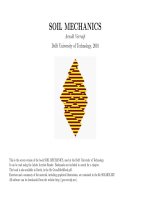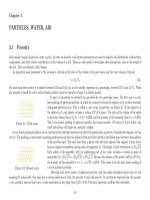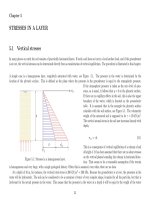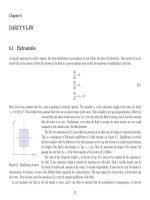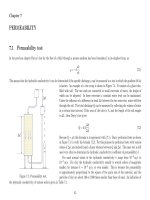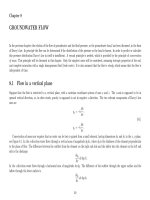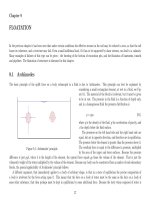Soil mechanics - Chapter 15 docx
Bạn đang xem bản rút gọn của tài liệu. Xem và tải ngay bản đầy đủ của tài liệu tại đây (153.75 KB, 6 trang )
Chapter 15
CONSOLIDATION
In the previous chapters it has been assumed that the deformation of a soil is uniquely determined by the stress. This means that a time dependent
response has been excluded. In reality the behavior is strongly dependent on time, however, especially for clay soils. This can be creep, but in a
.
.
.
.
.
.
.
.
.
.
.
.
.
.
.
.
.
.
.
.
.
.
.
.
.
.
.
.
.
.
.
.
.
.
.
.
.
.
.
.
.
.
.
.
.
.
.
.
.
.
.
.
.
.
.
.
.
.
.
.
.
.
.
.
.
.
.
.
.
.
.
.
.
.
.
.
.
.
.
.
.
.
.
.
.
.
.
.
.
.
.
.
.
.
.
.
.
.
.
.
.
.
.
.
.
.
.
.
.
.
.
.
.
.
.
.
.
.
.
.
.
.
.
.
.
.
.
.
.
.
.
.
.
.
.
.
.
.
.
.
.
.
.
.
.
.
.
.
.
.
.
.
.
.
.
.
.
.
.
.
.
.
.
.
.
.
.
.
.
.
.
.
.
.
.
.
.
.
.
.
.
.
.
.
.
.
.
.
.
.
.
.
.
.
.
.
.
.
.
.
.
.
.
.
.
.
.
.
.
.
.
.
.
.
.
.
.
.
.
.
Figure 15.1: Uniform load.
saturated soil the deformations can also be retarded by the time
that it takes for the water to flow out of the soil. In compression
of a soil the porosity decreases, and as a result there is less space
available for the pore water. This pore water may be be expelled
from the soil, but in clays this may take a certain time, due to
the small permeability. The process is called consolidation. Its
basic equations are considered in this chapter. T he analysis will
be restricted to one dimensional deformation, assuming that the
soil does not deform in lateral direction. It is also assumed that
the water can only flow in vertical direction. This will be the case during an oedometer test, or in the field, in case of a surcharge load over a
large area, see Figure 15.1.
15.1 Differential equation
To simplify the analysis it will be assumed that the change in stress is small compared to the initial stress. In that case the stress-strain relation
may be linearized, using an elastic coefficient D = K +
4
3
G, see (14.19). The precise value of that coefficient depends upon the initial stress.
The relation between the increment of effective stress ∆σ
and the increment of strain ∆ ε can now be written as
∆σ
= −(K +
4
3
G) ∆ε. (15.1)
In the remainder of this chapter the notation ∆ will be omitted. Thus the increment of the effective stress will be denoted simply by σ
, and
the increment of the strain by ε,
σ
= −(K +
4
3
G) ε. (15.2)
Using stresses and strains with respect to some initial state is very common in soil mechanics. For the strains there is actually no other possibility.
Strains can only be measured with respect to some initial state, and in this initial state the soil is not stres s free. Gravity is always acting,
and the stresses due to gravity have been developed gradually during geological history. The logical procedure is to regard the state of stress
90
Arnold Verruijt, Soil Mechanics : 15. CONSOLIDATION 91
including the influence of the weight of the soil layers as a given initial state, and to regard all effects of engineering activity with respect to that
initial state. It should be noted that to obtain the true stresses in the field the initial stresses should be added to the incremental stresses.
In the analysis of consolidation it is customary to write equation (15.2) in its inverse form,
ε = −m
v
σ
, (15.3)
where m
v
is denoted as the compressibility coefficient. If the incremental vertical total stress is denoted by σ, and the incremental pore pressure
by p, then Terzaghi’s principle of effective stress is
σ
= σ − p. (15.4)
It follows from (15.3) that
ε = −m
v
(σ − p). (15.5)
The total stress σ is often known, as a function of time. Its value is determined by the load. Let it be assumed that initially σ = 0, indicating no
.
.
.
.
.
.
.
.
.
.
.
.
.
.
.
.
.
.
.
.
.
.
.
.
.
.
.
.
.
.
.
.
.
.
.
.
.
.
.
.
.
.
.
.
.
.
.
.
.
.
.
.
.
.
.
.
.
.
.
.
.
.
.
.
.
.
.
.
.
.
.
.
.
.
.
.
.
.
.
.
.
.
.
.
.
.
.
.
.
.
.
.
.
.
.
.
.
.
.
.
.
.
.
.
.
.
.
.
.
.
.
.
.
.
.
.
.
.
.
.
.
.
.
.
.
.
.
.
.
.
.
.
.
.
.
.
.
.
.
.
.
.
.
.
.
.
.
.
.
.
.
.
.
.
.
.
.
.
.
.
.
.
.
.
.
.
.
.
.
.
.
.
.
.
.
.
.
.
.
.
.
.
.
.
.
.
.
.
.
.
.
.
.
.
.
.
.
.
.
.
.
.
.
.
.
.
.
.
.
.
.
.
.
.
.
.
.
.
.
.
.
.
.
.
.
.
.
.
.
.
.
.
.
.
.
.
.
.
.
.
.
.
.
.
.
.
.
.
.
.
.
.
.
.
.
.
.
.
.
.
.
.
.
.
.
.
.
.
.
.
.
.
.
.
.
.
.
.
.
.
.
.
.
.
.
.
.
.
.
.
.
.
.
.
.
.
.
.
.
.
.
.
.
.
.
.
.
.
.
.
.
.
.
.
.
.
.
.
.
.
.
.
.
.
.
.
.
.
.
.
.
.
.
.
.
.
.
.
.
.
.
.
.
.
.
.
.
.
.
.
.
.
.
.
.
.
.
.
.
.
.
.
.
.
.
.
.
.
.
.
.
.
.
.
.
.
.
.
.
.
.
.
.
.
.
.
.
.
.
.
.
.
.
.
.
.
.
.
.
.
.
.
.
.
.
.
.
.
.
.
.
.
.
.
.
.
.
.
.
.
.
.
.
.
.
.
.
.
.
.
.
.
.
.
.
.
.
.
.
.
.
.
.
.
.
.
.
.
.
.
.
.
.
.
.
.
.
.
.
.
.
.
.
.
.
.
.
.
.
.
.
.
.
.
.
.
.
.
.
.
.
.
.
.
.
.
.
.
.
.
.
.
.
.
.
.
.
.
.
.
.
.
.
.
.
.
.
.
.
.
.
.
.
.
.
.
.
.
.
.
.
.
.
.
.
.
.
.
.
.
.
.
.
.
.
.
.
.
.
.
.
.
.
.
.
.
.
.
.
.
.
.
.
.
.
.
.
.
.
.
.
.
.
.
.
.
.
.
.
.
.
.
.
.
.
.
.
.
.
.
.
.
.
.
.
.
.
.
.
.
.
.
.
.
.
.
.
.
.
.
.
.
.
.
.
.
.
.
.
.
.
.
.
.
.
.
.
.
.
.
.
.
.
.
.
.
.
.
.
.
.
.
.
.
.
.
.
.
.
.
.
.
.
.
.
.
.
.
.
.
.
.
.
.
.
.
.
.
.
.
.
.
.
.
.
.
.
.
.
.
.
.
.
.
.
.
.
.
.
.
.
.
.
.
.
.
.
.
.
.
.
.
.
.
.
.
.
.
.
.
.
.
.
.
.
.
.
.
.
.
.
.
.
.
.
.
.
.
.
.
.
.
.
.
.
.
.
.
.
.
.
.
.
.
.
.
.
.
.
.
.
.
.
.
.
.
.
.
.
.
.
.
.
.
.
.
.
.
.
.
.
.
.
.
.
.
.
.
.
.
.
.
.
.
.
.
.
.
.
.
.
.
.
.
.
.
x
y
q
x
q
x
+
∂q
x
∂x
dx
q
y
q
y
+
∂q
y
∂y
dy
Figure 15.2: Outflow.
additional load. During the application of the load the total stress σ is supposed to be increased
by a given amount, in a very short time interval, after which the total stress remains constant.
The pore pressure may vary during that period. To describe its generation and dissipation the
continuity of the water must be considered.
Consider an elementary volume V in the soil, see Figure 15.2. The volume of water is
V
w
= nV , where n is the porosity. The remaining volume, V
p
= (1 − n)V is the total volume
of the particles. As usual, the particles are considered as incompressible. This means that the
volume V can change only if the porosity changes. This is possible only if the water in the pores
is compressed, or if water flows out of the element.
The first possibility, a volume change by c ompression of the pore water, can be caused by a
change of the pore pressure p. It can be expected that the change of volume is proportional to
the change of the pressure, and to the original volume, i.e.
∆V
1
= −βV
w
∆p = −nβV ∆p, (15.6)
where β represents the compressibility of the water. For pure water handbooks of physics give β = 0.5 ×10
−9
m
2
/N, which is very small. Water
is practically incompressible. However, when the water contains some small bubbles of gas (air or natural gas), the value of β may be much
larger, approximately
β = Sβ
0
+
(1 −S)
p
0
, (15.7)
where β
0
is the compressibility of pure water, S is the degree of saturation, and p
0
is the absolute pressure in the water, considered with respect
to vacuum (this means that under atmospheric conditions p
0
= 100 kPa). If S = 0.99 and the pressure is p
0
= 100 kPa, then β = 10
−7
m
2
/N.
Arnold Verruijt, Soil Mechanics : 15. CONSOLIDATION 92
That is still a small value, but about 200 times larger than the compressibility of pure water. The apparent compressibility of the water is now
caused by the compression of the small air bubbles. The formula (15.7) can be derived on the basis of Boyle’s gas law. Taking into ac count the
compressibility of the fluid, even though the effect is small, makes the analysis more generally applicable.
The second possibility of a volume change, as a result of a net outflow of water, is described by the divergence of the specific discharge, see
Figure 15.2. There is a net loss of water when the outflow from the element is larger than the inflow into it. In a small time ∆t the volume
change is
∆V
2
= −(∇·q)V ∆t = −(
∂q
x
∂x
+
∂q
y
∂y
+
∂q
z
∂z
)V ∆t. (15.8)
The minus sign expresses that a positive value of ∇· q indicates that there is a net outflow, which means that the volume will decrease . The
volume increase ∆V
2
then is negative.
The total volume change in a small time ∆t now is
∆ε
vol
=
∆V
V
=
∆V
1
+ ∆V
2
V
= −nβ∆p −(
∂q
x
∂x
+
∂q
y
∂y
+
∂q
z
∂z
)∆t. (15.9)
After division by ∆t, and passing into the limit ∆t → 0, the resulting equation is
∂ε
vol
∂t
= −nβ
∂p
∂t
− (
∂q
x
∂x
+
∂q
y
∂y
+
∂q
z
∂z
). (15.10)
This is an important basic equation of the theory of consolidation, the storage equation. It expresses that a volume change (∂e/∂t) can be
caused by either a pressure change (the factor n indicating how much water is present, and the factor β indicating its compressibility), or by a
net outflow of water from the pores.
In the one dimensional case of vertical flow only, the storage equation reduces to
∂ε
vol
∂t
= −nβ
∂p
∂t
−
∂q
z
∂z
. (15.11)
The value of the specific discharge q
z
depends upon the pressure gradient, through Darcy’s law,
q
z
= −
k
γ
w
∂p
∂z
. (15.12)
It should be noted that it is not necessary to take into account a term for the pressure gradient due to gravity, because p indicates the increment
with respect to the initial state, in which gravity is taken into account.
It follows from (15.11) and (15.12), assuming that the hydraulic conductivity k is constant,
∂ε
vol
∂t
= −nβ
∂p
∂t
+
k
γ
w
∂
2
p
∂z
2
. (15.13)
Arnold Verruijt, Soil Mechanics : 15. CONSOLIDATION 93
This equation contains two variables, the volume strain ε
vol
and the fluid pressure p. Another equation is needed for a full description of the
problem. This second equation is provided by the relation of the deformation of the soil to the stresses.
In the one dimensional case considered here the lateral strains are zero, so that the volume strain ε
vol
is equal to the vertical strain ε,
ε
vol
= ε. (15.14)
It now follows from (15.5), (15.13) and (15.14), if it is assumed that the compressibility m
v
is constant in time,
∂p
∂t
=
m
v
m
v
+ nβ
∂σ
∂t
+ c
v
∂
2
p
∂z
2
, (15.15)
where c
v
is the consolidation coefficient,
c
v
=
k
γ
w
(m
v
+ nβ)
. (15.16)
Equation (15.15) is the basic differential equation for the one dimensional consolidation process. From this equation the pore pressure p must
be determined.
The simplest type of loading occurs when the total stress σ is constant during the entire process. This will be the case if the load does not
change after its initial application. Then
∂p
∂t
= c
v
∂
2
p
∂z
2
, (15.17)
In mathematical physics an equation of this type is denoted as a diffusion equation. The same equation describes the process of heating or
cooling of a strip of metal. The variable then is the temperature.
It may be noted that the differential equation does not become simpler when the water is assumed to be incompressible (β = 0). Only the
coefficient c
v
is affected. The compressibility of the water does not complicate the mathematics.
Arnold Verruijt, Soil Mechanics : 15. CONSOLIDATION 94
15.2 Boundary conditions and initial condition
To complete the formulation of the problem, the boundary conditions and initial conditions must be added to the differential equation (15.17). In
.
.
.
.
.
.
.
.
.
.
.
.
.
.
.
.
.
.
.
.
.
.
.
.
.
.
.
.
.
.
.
.
.
.
.
.
.
.
.
.
.
.
.
.
.
.
.
.
.
.
.
.
.
.
.
.
.
.
.
.
.
.
.
.
.
.
.
.
.
.
.
.
.
.
.
.
.
.
.
.
.
.
.
.
.
.
.
.
.
.
.
.
.
.
.
.
.
.
.
.
.
.
.
.
.
.
.
.
.
.
.
.
.
.
.
.
.
.
.
.
.
.
.
.
.
.
.
.
.
.
.
.
.
.
.
.
.
.
.
.
.
.
.
.
.
.
.
.
.
.
.
.
.
.
.
.
.
.
.
.
.
.
.
.
.
.
.
.
.
.
.
.
.
.
.
.
.
.
.
.
.
.
.
.
.
.
.
.
.
.
.
.
.
.
.
.
.
.
.
.
.
.
.
.
.
.
.
.
.
.
.
.
.
.
.
.
.
.
.
.
.
.
.
.
.
.
.
.
.
.
.
.
.
.
.
.
.
.
.
.
.
.
.
.
.
.
.
.
.
.
.
.
.
.
.
.
.
.
.
.
.
.
.
.
.
.
.
.
.
.
.
.
.
.
.
.
.
.
.
.
.
.
.
.
.
.
.
.
.
.
.
.
.
.
.
.
.
.
.
.
.
.
.
.
.
.
.
.
.
.
.
.
.
.
.
.
.
.
.
.
.
.
.
.
.
.
.
.
.
.
.
.
.
.
.
.
.
.
.
.
.
.
.
.
.
.
.
.
.
.
.
.
.
.
.
.
.
.
.
.
.
.
.
.
.
.
.
.
.
.
.
.
.
.
.
.
.
.
.
.
.
.
.
.
.
.
.
.
.
.
.
.
.
.
.
.
.
.
.
.
.
.
.
.
.
.
.
.
.
.
.
.
.
.
.
.
.
.
.
.
.
.
.
.
.
.
.
.
.
.
.
.
.
.
.
.
.
.
.
.
.
.
.
.
.
.
.
.
.
.
.
.
.
.
.
.
.
.
.
.
.
.
.
.
.
.
.
.
.
.
.
.
.
.
.
.
.
.
.
.
.
.
.
.
.
.
.
.
.
.
.
.
.
.
.
.
.
.
.
.
.
.
.
.
.
.
.
.
.
.
.
.
.
.
.
.
.
.
.
.
.
.
.
.
.
.
.
.
.
.
.
.
.
.
.
.
.
.
.
.
.
.
.
.
.
.
.
.
.
.
.
.
.
.
.
.
.
.
.
.
.
.
.
.
.
.
.
.
.
.
.
.
.
.
.
.
.
.
.
.
.
.
.
.
.
.
.
.
.
.
.
.
.
.
.
.
.
.
.
.
.
.
.
.
.
.
.
.
.
.
.
.
.
.
.
.
.
.
.
.
.
.
.
.
.
.
.
.
.
.
.
.
.
.
.
.
.
.
.
.
.
.
.
.
.
.
.
.
.
.
.
.
.
.
.
.
.
.
.
.
.
.
.
.
.
.
.
.
.
.
.
.
.
.
.
.
.
.
.
.
.
.
.
.
.
.
.
.
.
.
.
.
.
.
.
.
.
.
.
.
.
.
.
.
.
.
.
.
.
.
.
.
.
.
.
.
.
.
.
.
.
.
.
.
.
.
.
.
.
.
.
.
.
.
.
.
.
.
.
.
.
.
.
.
.
.
.
.
.
.
.
.
.
.
.
.
.
.
.
.
.
.
.
.
.
.
.
.
.
.
.
.
.
.
.
.
.
.
.
.
.
.
.
.
.
.
.
.
.
.
.
.
.
.
.
.
.
.
.
. .
.
.
.
.
.
.
.
.
.
.
.
.
.
.
.
.
.
.
.
.
.
.
.
.
.
.
.
.
.
.
.
.
.
.
.
.
.
.
.
.
.
.
.
.
.
.
.
.
.
.
.
.
.
.
.
.
.
.
.
.
.
.
.
.
.
.
.
.
.
.
.
.
.
.
.
.
.
.
.
.
.
.
.
.
.
.
.
.
.
.
.
.
.
.
.
.
.
.
.
.
.
.
.
.
.
.
.
.
.
.
.
.
.
.
.
.
.
.
.
.
.
.
.
.
.
.
.
.
.
.
.
.
.
.
.
.
.
.
.
.
.
.
.
.
.
.
.
.
.
.
.
.
.
.
.
.
.
.
.
.
.
.
.
.
.
.
.
.
.
.
.
.
.
.
.
.
.
.
.
.
.
.
.
.
.
.
.
.
.
.
.
.
.
.
.
.
.
.
.
.
.
.
.
.
.
.
.
.
.
.
.
.
.
.
.
.
.
.
.
.
.
.
.
.
.
.
.
.
.
.
.
.
.
.
.
.
.
.
.
.
.
.
.
.
.
.
.
.
.
.
.
.
.
.
.
.
.
.
.
.
.
.
.
.
.
.
.
.
.
.
.
.
.
.
.
.
.
.
.
.
.
.
.
.
.
.
.
.
.
.
.
.
.
.
.
.
.
.
.
.
.
.
.
.
.
.
.
.
.
.
.
.
.
.
.
.
.
.
.
.
.
.
.
.
.
.
.
.
.
.
.
.
.
.
.
.
.
.
.
.
.
.
.
.
.
.
.
.
.
.
.
.
.
.
.
.
.
.
.
.
.
.
.
.
.
.
.
.
.
.
.
.
.
.
.
.
.
.
.
.
.
.
.
.
.
.
.
.
.
.
.
.
.
.
.
.
.
.
.
.
.
.
.
.
.
.
.
.
.
.
.
.
.
.
.
.
.
.
.
.
.
.
.
.
.
.
.
.
.
.
.
.
.
.
.
.
.
.
.
.
.
.
.
.
.
.
.
.
.
.
.
.
.
.
.
.
.
.
.
.
.
.
.
.
.
.
.
.
.
.
.
.
.
.
.
.
.
.
.
.
.
.
.
.
.
.
.
.
.
.
.
.
.
.
.
.
.
.
.
.
.
.
.
.
.
.
.
.
.
.
.
.
.
.
.
.
.
.
.
.
.
.
.
.
.
.
.
.
.
.
.
.
.
.
.
.
.
.
.
.
.
.
.
.
.
.
.
.
.
.
.
.
.
.
.
.
.
.
.
.
.
.
.
.
.
.
.
.
.
.
.
.
.
.
.
.
.
.
.
.
.
.
.
.
.
.
.
.
.
.
.
.
.
.
.
.
.
.
.
.
.
.
.
.
.
.
.
.
.
.
.
.
.
.
.
.
.
.
.
.
.
.
.
.
.
.
.
.
.
.
.
.
.
.
.
.
.
.
.
.
.
.
.
.
.
.
.
.
.
.
.
.
.
.
.
.
.
.
.
.
.
.
.
.
.
.
.
.
.
.
.
.
.
.
.
.
.
.
.
.
.
.
.
.
.
.
.
.
.
.
.
.
.
.
.
.
.
.
.
.
.
.
.
.
.
.
.
.
.
.
.
.
.
.
.
.
.
.
.
.
.
.
.
.
.
.
.
.
.
.
.
.
.
.
.
.
.
.
.
.
.
.
.
.
.
.
.
.
.
.
.
.
.
.
.
.
.
.
.
.
.
.
.
.
.
.
.
.
.
.
.
.
.
.
.
.
.
.
.
.
.
.
.
.
.
.
.
.
.
.
.
.
.
.
.
.
.
.
.
.
.
.
.
.
.
.
.
.
.
.
.
.
.
.
.
.
.
.
.
.
.
.
.
.
.
.
.
.
.
.
.
.
.
.
.
.
.
.
.
.
.
.
.
.
.
.
.
.
.
.
.
.
.
.
.
.
.
.
.
.
.
.
.
.
.
.
.
.
.
.
.
.
.
.
.
.
.
.
.
.
.
.
.
.
.
.
.
.
.
.
.
.
.
.
.
.
.
.
.
.
.
.
.
.
.
.
.
.
.
.
.
.
.
.
.
.
.
.
.
.
.
.
.
.
.
.
.
.
.
.
.
.
.
.
.
.
.
.
.
.
.
.
.
.
.
.
.
.
.
.
.
.
.
.
.
.
.
.
.
.
.
.
.
.
.
.
.
.
.
.
.
.
.
.
.
.
.
.
.
.
.
.
.
.
.
.
.
.
.
.
.
.
.
.
.
.
.
.
.
.
.
.
.
.
.
.
.
.
.
.
.
.
.
.
.
.
.
.
.
.
.
.
.
.
.
.
.
.
.
.
.
.
.
.
.
.
.
.
.
.
.
.
.
.
.
.
.
.
.
.
.
.
.
.
.
.
.
.
.
.
.
.
.
.
.
.
.
.
.
.
.
.
.
.
.
.
.
.
.
.
.
.
.
.
.
.
.
.
.
.
.
.
.
.
.
.
.
.
.
.
.
.
.
.
.
.
.
.
.
.
.
.
.
.
.
.
.
.
.
.
.
.
.
.
.
.
.
.
.
.
.
.
.
.
.
.
.
.
.
.
.
.
.
.
.
.
.
.
.
.
.
.
.
.
.
.
.
.
.
.
.
.
.
.
.
.
.
.
.
.
.
.
.
.
.
.
.
.
.
.
.
.
.
.
.
.
.
.
.
.
.
.
.
.
.
.
.
.
.
.
.
.
.
.
.
.
.
.
.
.
.
.
.
.
.
.
.
.
.
.
.
.
.
.
.
.
.
.
.
.
.
.
.
.
.
.
.
.
.
.
.
.
.
.
.
.
.
.
.
.
.
.
.
.
.
.
.
.
.
.
.
.
.
.
.
.
.
.
.
.
.
.
.
.
.
.
.
.
.
.
.
.
.
.
.
.
.
.
.
.
.
.
.
.
.
.
.
.
.
.
.
.
.
.
.
.
.
.
.
.
.
.
.
.
.
.
.
.
.
.
.
.
.
.
.
.
.
.
.
.
.
.
.
.
.
.
.
.
.
.
.
.
.
.
.
.
.
.
.
.
.
.
.
.
.
.
.
.
.
.
.
.
.
.
.
.
.
.
.
.
.
.
.
.
.
.
.
.
.
.
.
.
.
.
.
.
.
.
.
.
.
.
.
.
.
.
.
.
.
.
.
.
.
.
.
.
.
.
.
.
.
.
.
.
.
.
.
.
.
.
.
.
.
.
.
.
.
.
.
.
.
.
.
.
.
.
.
.
.
.
.
.
.
.
.
.
.
.
.
.
.
.
.
.
.
.
.
.
.
.
.
.
.
.
.
.
.
.
.
.
.
.
.
.
.
.
.
.
.
.
.
.
.
.
.
.
.
.
.
.
.
.
.
.
.
.
.
.
.
.
.
.
.
.
.
.
.
.
.
.
.
.
.
.
.
.
.
.
.
.
.
.
.
.
.
.
.
.
.
.
.
.
.
.
.
.
.
.
.
.
.
.
.
.
.
.
.
.
.
.
.
.
.
.
.
.
.
.
.
.
.
.
.
.
.
.
.
.
.
.
.
.
.
.
.
.
.
.
.
.
.
.
.
.
.
.
.
.
.
.
.
.
.
.
.
.
.
.
.
.
.
.
.
.
.
.
.
.
.
.
.
.
.
.
.
.
.
.
.
.
.
.
.
.
.
.
.
.
.
.
.
.
.
.
.
.
.
.
.
.
.
.
.
.
.
.
.
.
.
.
.
.
.
.
.
.
.
.
.
.
.
.
.
.
.
.
.
.
.
.
.
.
.
.
.
.
.
.
.
.
.
.
.
.
.
.
.
.
.
.
.
.
.
.
.
.
.
.
.
.
.
.
.
.
.
.
.
.
.
.
.
.
.
.
.
.
.
.
.
.
.
.
.
.
.
.
.
.
.
.
.
.
.
.
.
.
.
.
.
.
.
.
.
.
.
.
.
.
.
.
.
.
.
.
.
.
.
.
.
.
.
.
.
.
.
.
.
.
.
.
.
.
.
.
.
.
.
.
.
.
.
.
.
.
.
.
.
.
.
.
.
.
.
.
.
.
.
.
.
.
.
.
.
.
.
.
.
.
.
.
.
.
.
.
.
.
.
.
.
.
.
.
.
.
.
.
.
.
.
.
.
.
.
.
.
.
.
.
.
.
.
.
.
.
.
.
.
.
.
.
.
.
.
.
.
.
.
.
.
.
.
.
.
.
.
.
.
.
.
.
.
.
.
.
.
.
.
.
.
.
.
.
.
.
.
.
.
.
.
.
.
.
.
.
.
.
.
.
.
.
.
.
.
.
.
.
.
.
.
.
.
.
.
.
.
.
.
.
.
.
.
.
.
.
.
.
.
.
.
.
.
.
.
.
.
.
.
.
.
.
.
.
.
.
.
.
.
.
.
.
.
.
.
.
.
.
.
.
.
.
.
.
.
.
.
.
.
.
.
.
.
.
.
.
.
.
.
.
.
.
.
.
.
.
.
.
.
.
.
.
.
.
.
.
.
.
.
.
.
.
.
.
.
.
.
.
.
.
.
.
.
.
.
.
.
.
.
.
.
.
.
.
.
.
.
.
.
.
.
.
.
.
.
.
.
.
.
.
.
.
.
.
.
.
.
.
.
.
.
.
.
.
.
.
.
.
.
.
.
.
.
.
.
.
.
.
.
.
.
.
.
.
.
.
.
.
.
.
.
.
.
.
.
.
.
.
.
.
.
.
.
.
.
.
.
.
.
.
.
.
.
.
.
.
.
.
.
.
.
.
.
.
.
.
.
.
.
.
.
.
.
.
.
.
.
.
.
.
.
.
.
.
.
.
.
.
.
.
.
.
.
.
.
.
.
.
.
.
.
.
.
.
.
.
.
.
.
.
.
.
.
.
.
.
.
.
.
.
.
.
.
.
.
.
.
.
.
.
.
.
.
.
.
.
.
.
.
.
.
.
.
.
.
.
.
.
.
.
.
.
.
.
.
.
.
.
.
.
.
.
.
.
.
.
.
.
.
.
.
.
.
.
.
.
.
.
.
.
.
.
.
.
.
.
.
.
.
.
.
.
.
.
.
.
.
.
.
.
.
.
.
.
.
.
.
.
.
.
.
.
.
.
.
.
.
.
.
.
.
.
.
.
.
.
.
.
.
.
.
.
.
.
.
.
.
.
.
.
.
.
.
.
.
.
.
.
.
.
.
.
.
.
.
.
.
.
.
.
.
.
.
.
.
.
.
.
.
.
.
.
.
.
.
.
.
.
.
.
.
.
.
.
.
.
.
.
.
.
.
.
.
.
.
.
.
.
.
.
.
.
.
.
.
.
.
.
.
.
.
.
.
.
.
.
.
.
.
.
.
.
.
.
.
.
.
.
.
.
.
.
.
.
.
.
.
.
.
.
.
.
.
.
.
.
.
.
.
.
.
Figure 15.3: Oedometer test.
the case of an oedometer test, see Figure 15.3, the sample is usually drained at
the top, using a thin sheet of filter paper and a steel porous plate, or a porous
stone. In the container in which the sample and its surrounding ring are placed,
the water level is kept constant. This means that at the top of the sample the
excess pore pressure is zero,
z = h : p = 0. (15.18)
The soil sample may also be drained at its bottom, but alternatively, it may be
supported by an impermeable plate. In that case the boundary condition at the
bottom of the sample is
z = 0 :
∂p
∂z
= 0, (15.19)
indicating no outflow at the bottom of the sample. These two boundary conditions are physically sufficient. In general a se cond order differential
equation requires two boundary conditions.
The initial condition is determined by the way of loading. A common testing procedure is that a load is applied in a very short time (by
placing a weight on the loading plate). After this loading the load is kept constant. At the time of loading an immediate increase of the pore
pressure is generated, that can be determined in the following way. The storage equation (15.10) is integrated over a short time interval ∆t,
giving
ε
vol
= −nβp −
∆t
0
∂q
z
∂z
dt.
The integral represents the amount of water that has flowed out of the soil in the time interval ∆t. If ∆t → 0 this must be zero, so that
t = 0 : ε
vol
= −nβp. (15.20)
On the other hand, it follows from (15.5), taking into account that in this case ε
vol
= ε,
ε
vol
= −m
v
(σ − p). (15.21)
From equations (15.20) and (15.21) it now follows that
t = 0 : p =
σ
1 + nβ/m
v
. (15.22)
Arnold Verruijt, Soil Mechanics : 15. CONSOLIDATION 95
This is the initial condition. It means that at the time of loading, t = 0, the pore water pressure p is given.
If the water is considered as completely incompressible (that is a reasonable assumption when the soil is completely saturated with water)
eq. (15.22) reduces to
t = 0, β = 0 : p = σ. (15.23)
In that case the initial pore pressure equals the given load. That can be understood by noting that in case of an incompressible pore fluid there
can be no immediate volume change. This means that there can be no vertical strain, as the volume change equals the vertical strain in this
case of a sample that is laterally confined by the stiff s teel ring. Hence there can be no vertical strain at the moment of loading, and therefore
the effective stress can not increase at that instant. In this case, of lateral confinement and incompressible water, the entire load is initially
carried by the water in the pores.
It should be noted that throughout this chapter the deformation and the flow are one dimensional. In a more general three dimensional case,
there may be lateral deformations, and an immediate deformation is very well possible, although the volume must remain constant if the fluid
is incompressible. There can then be an immediate change of the effective stresses. The water will then carry only part of the load. The three
dimensional theory of consolidation is an interesting topic for further study.

